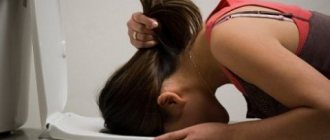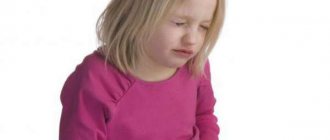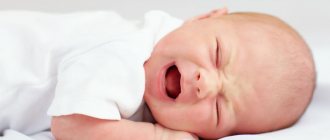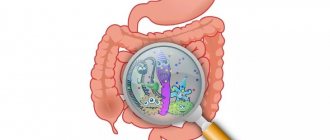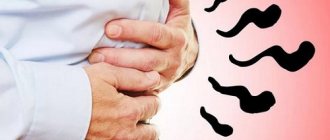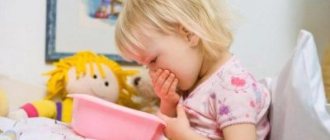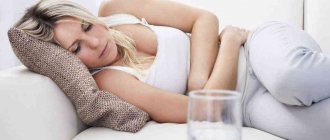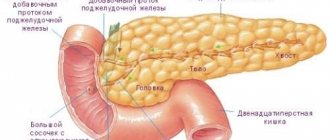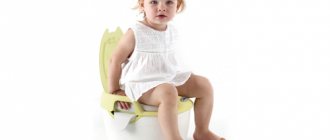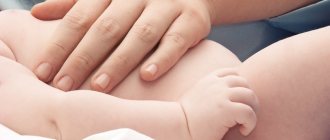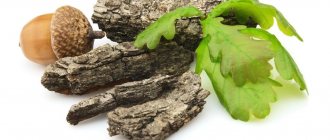About the problem
Diarrhea is a manifestation of the body’s ability to get rid of bacteria and viruses, of which there are a great many around the child. Neither the water that the baby drinks, nor the food, nor the air is sterile. What can we say about playing in the sandbox, crawling on the grass, on the floor, etc. Humans have several such protective “systems”: saliva is designed to destroy microbes at the stage of entering the mouth, bronchial and nasal mucus protect the respiratory organs from getting into them bacteria and viruses, gastric juice effectively destroys those microorganisms that managed to enter the body through the mouth and reach the digestive organs unharmed. Bacteria, which are the indigenous inhabitants, await “uninvited guests” in the intestines. Their task is to prevent malicious agents from taking root.
Diarrhea in a child can be caused by an intestinal infection that enters the mouth through unwashed hands, poorly washed vegetables and fruits, through water, or with food. Often these are bacteria.
Some viruses, such as rotavirus, also cause diarrhea. The intestinal mucosa is an excellent breeding ground for their reproduction, and therefore digestion is disrupted, the intestinal mucosa is irritated and diarrhea occurs.
Medicines for diarrhea for a 1 year old child
All medications are prescribed in accordance with the individual and age characteristics of the small patient. Dosages and frequency of administration are prescribed by doctors.
Antibacterial drugs
Antibacterial drugs are the main treatment for diarrhea caused by intestinal infections. They must be taken with great care, since not all medications can be used at this age.
The most commonly prescribed intestinal antiseptic is furazolidone. But you shouldn’t give it unless the cause of the baby’s diarrhea is cleared up. Nifuroxazide is easier to use, since it is available immediately in the finished syrup form.
If the disease is caused by rotavirus, enterovirus, adenovirus infection or other viral agents, then antiviral immunomodulators are prescribed in complex therapy.
The drugs are Arbidol for children, Interferons. Arbidol is contained in capsules. It will be difficult for 1-year-old children to swallow it, so the contents of the capsules are poured onto a spoon and diluted with water to form a suspension. The baby can easily swallow it.
Interferons are available in the form of rectal suppositories.
Intestinal sorbents
The next step is to take intestinal sorbents; a huge amount of them is released. The most common and cheapest is activated carbon, sold in pharmacies in tablet form.
It is difficult for a child to take them; the mother herself crushes each tablet, crushes it and adds it to some water so that the baby drinks the solution from the papilla.
Activated carbon contains granules that bind toxic substances to the intestinal mucosa and remove them, and has strengthening properties.
Polysorb is a modern and newer sorbent, more expensive than coal. The advantage is that it is sold immediately in powder form for ease of administration to children.
Depending on weight and age, it is diluted with boiled water and given to drink several times a day; it has a larger adsorption surface and removes more toxins. Helps cope with intoxication and dehydration, tastes good.
A very convenient form of using sorbents is gels and pastes, these include Neosmectin, Enterosgel and Sorbitol. Such substances can be spread on a cookie or simply poured into the baby’s mouth, then given some water to drink.
The action is not inferior to solid sorbents, they are not absorbed into the bloodstream, and are excreted from the body along with feces. Helps cope with intoxication and allergic reactions.
Polyphepan has a mixed effect and is recommended for use from the first days of life. It is an adsorbent, antidiarrheal, and antibacterial drug.
The release form is a ready-made suspension, it is easy to use, has proven itself, and is highly effective.
Restoration of water and electrolyte balance
If the patient is not hospitalized, but is being treated at home, the mother needs to desolder him herself. This should be done gradually, in small portions; you can give 1 teaspoon of water every 10 minutes.
The liquid should be clean, boiled, at room temperature, excluding juices completely. In order to restore salt balance and electrolyte balance, special means are prescribed.
Rehydron is recommended for use from 6 months of age. Available in powder form for preparing a solution. Indicated for diseases with diarrhea and vomiting, it treats well dehydration of 1-2 degrees.
Hydrovit is used in children from the first days of life. Sold in powdery consistency. Diluted with water. It has proven itself as an antidiarrheal and antipyretic agent. Fights intoxication.
Reosolan. It can be taken by the youngest patients. Also available in powder form. Contraindicated in children with diabetes and impaired renal function.
Prebiotics and probiotics
Preparations for restoring normal microflora, this includes prebiotics and probiotics.
Prebiotics are substances that contain components for the growth of beneficial bacteria in the intestines. These include Normobact, Hilak Forte, Acipol, all of which are allowed from childhood.
Probiotics are medicines containing ready-made beneficial bacteria. Linex forte and Enterol are allowed for children; they are available in capsules.
Their contents must be poured out and dissolved in water. They have a fixing effect, actively restore microflora, and promote stable digestion.
Danger of diarrhea
The most serious danger of diarrhea lies in the possibility of dehydration . The younger the child, the higher this risk. Potassium, calcium, and sodium salts, which are extremely important for life, are released with feces. Fluid is rapidly lost. Therefore, it is not as scary if a 3-year-old child goes to the toilet five times a day and does not show signs of dehydration as if five times diarrhea happened to a 6-month-old baby. After all, the baby’s reserves of water and mineral salts are much more meager, and he loses them at a faster rate.
Severe dehydration can cause serious problems with the nervous system and can also be fatal for an infant.
Treatment
If diarrhea is caused by a viral infection, and in addition to frequent trips to the toilet, there are all the signs of a viral illness, you should not feed the child antiviral drugs, they do not help and their effectiveness has not been clinically proven. Antibiotics are also inappropriate because they have no effect on viruses. No special treatment is required; it is enough to provide the child with the right help and prevent dehydration. If diarrhea is the result of food poisoning or intestinal infection, the treatment approach should be the same.
First of all, you should make sure that the baby is not dehydrated.
If a child does not pee for 6 hours, if he cries with dry eyes, without tears, if he has blue circles under his eyes, sharpened facial features, dry lips, tongue, dry mucous membranes - these are very alarming symptoms. Immediate medical attention is required, you need to call an ambulance.
To prevent such a dangerous condition, parents’ actions in case of diarrhea must be coordinated and clear:
- The child definitely needs to drink. And drink a lot. All drinks should be warm, about 20 degrees, so that the liquid is absorbed and absorbed by the body as quickly as possible. If a child refuses to drink from a cup, he should be fed with a spoon, little by little but often. If he does not drink from a spoon, as children under 7-9 months often do, then you need to draw the liquid into a disposable syringe without a needle and drink from it drip-wise. If the baby resists this method, you should not wait and persuade, you should immediately call an ambulance so that you can administer liquid to the child by drip.
- The child needs to restore the balance of salts . To do this, Komarovsky advises using ready-made pharmaceutical sachets with oral rehydration products. "Smecta" is suitable, you can buy "Regidron" or "Humana-Electrolyte" . These drugs must be in every family's home medicine cabinet. If diarrhea has already occurred, and there are no such drugs, you can use a recipe that has received full approval from the World Health Organization: add a teaspoon of salt and the same amount of soda to a liter of water. You can also give your child this solution.
- Need control over secretions. What you drink should stand out. As long as the baby, who has not yet reached the age of one, wears diapers, the mother has nothing to worry about. At any time, she can measure the amount the child drinks, and after 3 hours weigh his used diaper on an electronic kitchen scale to understand whether the water is being excreted normally. If the child is already using the potty, control will also not be difficult. But a 2-year-old child, who has most likely already mastered the toilet, will have to follow on his heels.
- The child does not need food. You should not try to feed him at any cost. Diarrhea will go away much faster if the baby is hungry. You should give food only when he asks for it. If you have diarrhea, you should not eat fatty or sweet foods, drink carbonated drinks and milk. It is better to give porridge, mashed potatoes, crackers from yeast-free bread, vegetable soup with lean broth.
- Activated carbon - in the correct dosage. Another useful drug that should be in your home medicine cabinet. Parents should remember that activated carbon is dosed at 1 tablet for every 10 kilograms of body weight at a time. Thus, a child weighing 10 kilograms is given 1 tablet, and a baby whose weight is 15 kilograms is given 1.5 tablets. Modern medicine recommends modern enterosorbents, which are easier to take. If the financial capabilities of the family allow, you can buy and keep Enterosgel in the first aid kit for such cases.
Digestive system in a child under one year old
To distinguish between the natural and pathological conditions of the baby, parents should immediately study the physiological characteristics of children's feces. This will allow you not to worry once again and avoid taking treatment measures unless absolutely necessary. The first thing to understand is that the stool of a child and an adult are very different. Therefore, no comparative analogies should be made in the process of independent examination of feces.
When the diet consists of only breast milk, diarrhea in the newborn is unlikely. Breast milk is an ideal, easily digestible product that also has a bactericidal effect. But the stool of children and infants is loose and unformed. It has a liquid consistency and contains lumps of milk processed in the gastrointestinal tract. The number of bowel movements per day is 5–6 times, depending on the individual characteristics of digestive function and the degree of enzyme activity.
If the stool at this time (the first few months of life) is hard, this phenomenon is usually regarded as constipation.
In a baby, you can observe a certain sequence of changes in stool. During the first few days after birth, meconium, the original feces, begins to pass. It may resemble a thin paste, putty, and have a black or brown tint. When trying to wash it off the diaper and butt, difficulties may arise.
As soon as the period of breastfeeding begins, the stool acquires a liquid consistency. They become patchy and contain white lumps (this is processed milk and is absolutely normal). The feces have a sour odor and a yellow (light brown) color.
As you grow older and your diet improves, stool becomes less frequent (3-4 times a day). When the baby is healthy, during the process of bowel movements he behaves naturally, nothing disturbs or disturbs him. Closer to the age of one, the feces are completely formed, and trips to the toilet occur only 1-2 times a day.
Doctor Komarovsky's opinion
Diarrhea and vomiting are powerful natural mechanisms for removing toxic substances from the body. Most often, loose stools are a consequence of pathogenic microbes entering the gastrointestinal tract due to poorly washed vegetables and fruits, licking dirty hands, drinking unpurified water, and helminthic infestations. Some viruses cause stool upset by entering the body through the mucous membranes and causing inflammation, which is why diarrhea occurs.
Not every uncontrollable, repeated loose bowel movement in a child can rightly be called diarrhea. It all depends on the baby’s age and type of feeding. The true cause of the disorder will be determined by the doctor in order to avoid unpleasant consequences and not miss time for treatment, since it is necessary to act in two directions: minimizing the consequences of diarrhea and eliminating the cause of its occurrence. Therapy for diarrhea is aimed at restoring the mucous barrier of the intestinal walls and eliminating foci of intoxication in the gastrointestinal tract. You should not hesitate to drink if your baby has loose stools. At the pharmacy it is worth purchasing special mineral solutions that help prevent rapid dehydration of the patient. Drinking plenty of fluids is an important thing that a mother should provide if her child has diarrhea.
Frequent bowel movements due to fermentopathy
This is one of the most common causes of bowel dysfunction in children aged 1 to 7 years. Enzymopathy is a pathological condition in which a child’s digestive tract does not produce enough necessary enzymes (or they are completely absent). Enzymopathy also includes insufficient enzymatic activity, which leads to impaired breakdown and absorption of nutrients and slower absorption.
Signs of enzyme deficiency in children include:
- frequent stools, the consistency of which can vary throughout the day from watery liquid to a dense sausage shape;
- pungent odor of feces (explained by rotting products of incomplete breakdown of proteins, fats and other elements);
- an increase in the volume of detritus in the feces (determined in the laboratory; it may appear externally as a glossy sheen on the surface of the excrement);
- anemia due to incomplete absorption of iron (pallor of the skin, gray skin tone, dryness and peeling of the mucous membranes);
- headaches, weakness, fatigue, decreased performance in children who attend educational institutions.
Children's headaches
Note! Impaired absorption of vitamins, amino acids and mineral salts leads to a decrease in the body’s overall resistance and weakened immunity. The child may often suffer from colds and other infectious diseases (including parasitic infestations).
What to do?
If a child is diagnosed with fermentopathy, it is necessary to determine its type: drug therapy for the pathology and subsequent correction of the child’s lifestyle depend on this.
Table. Types of enzymopathy in children.
| Variety | Characteristic |
| Hereditary | It develops against the background of genetic changes and the complete absence of one or more digestive enzymes. It is detected mainly in the first year of a child’s life and requires lifelong replacement therapy. |
| Nutritional | The cause is chronic eating disorders. Experts believe that the main factor is insufficient protein intake from food. |
For any form of enzyme deficiency, the use of digestive enzymes (Festal, Creon, Mezim) is indicated, but only a doctor should prescribe these drugs, since not all of them are suitable for use in childhood. In case of nutritional disorders, it is recommended to increase the proportion of protein products in the children's diet by approximately 10-15%. This can be meat, cottage cheese, eggs (white), fish, as well as legumes (chickpeas, peas, lentils, beans).
Important! An increase in the volume fraction of protein products in a child’s daily menu is not allowed in case of kidney disease, as this can lead to the appearance of protein in the urine (proteinuria).
What do the accompanying symptoms indicate?
The origin of diarrhea is indicated by accompanying symptoms or their absence. Prolonged diarrhea without fever indicates disturbances in the digestive system and psychological distress of the child. Digestive problems occur when there is brown mucus in the stool, a sour odor, or when the color of the stool changes to green or black. While taking certain medications that stimulate digestion, children may experience diarrhea; it is important to monitor the dosage. Usually this disorder stops when the drug is removed from the body.
Diarrhea with vomiting is a sign of an intestinal infection. Often such symptoms manifest themselves against the background of pain and cramping in the abdomen. The body removes toxins in accessible ways, and eliminating diarrhea and vomiting in the case of an intestinal infection is not always justified.
If an increase in body temperature joins the existing symptoms, the sick child must be hospitalized. The temperature threatens the baby with seizures. The blood thickens, the load on the heart and blood vessels increases, and fluid loss aggravates the situation. Komarovsky considers vomiting, diarrhea, and fever in a child to be an unjustified risk. The best way to alleviate the condition in this case is to contact a specialist.
Diarrhea with blood indicates the presence of internal bleeding in the digestive organs. The darker the stool, the higher the inflammation is located from the rectum. If the blood in the stool is a rich scarlet color, we are talking about cracks in the anus and rectum. The reasons may be imperfection of the digestive organs, which is expressed by alternating constipation and diarrhea. The reason for the presence of blood in the stool is determined by the doctor based on the results of the necessary tests and studies.
How to understand that it is diarrhea
In a 2-4 month old baby, it is not easy to distinguish diarrhea from the norm, because his digestive organs are in active development and frequent loose stools are normal.
How can you tell if your baby has diarrhea? Acts of defecation occur 9 or more times a day. If the stool emits a sharp, unpleasant odor, mixed with various impurities, this will indicate diarrhea.
In infancy, the disease is fraught with enormous danger, as it is fraught with asthenia, dehydration and loss of nutrients by the body. On the other hand, diarrhea acts as a natural reaction to digestive disorders and is a true signal of disturbances in the body.
In comparison with classic baby feces, which also has a liquid consistency, diarrhea will be uncontrollable and is accompanied by an irresistible desire of the child to empty his bowels. Additional identifying symptoms include flatulence, nausea, gag reflex, and stomach cramps. The number of bowel movements does not play a decisive role.
Color
In normal condition, a baby's stool is often liquid and yellow or sandy in color with a brown tint. If the color becomes excessively dark or light, acquires a greenish, dark brown, or black tone, this indicates a deviation and requires consultation with a physician.
Smell
Normally, infant feces have a neutral-sour odor. If it becomes unbearably unpleasant and smelly, this is a cause for concern.
Consistency
Another way to determine that a baby has diarrhea is to take a closer look at the consistency of the stool. In the first few weeks of life, stools are loose and frequent. After 2–3 months it becomes thicker, more like an adult. With the addition of complementary foods to the diet, it becomes even more formed. By the time the child reaches one year old, the feces resemble “sausage” (soft) or mush (thick).
Impurities
Normally they are absent. That is, there should be no foam, blood fluid and its veins, mucus, pus, or “greenery”. If such changes were detected by parents, this may indicate a serious infection or a lack of enzymes.
In order to recognize diarrhea in an infant in a timely manner and identify violations, and then take appropriate measures, it is necessary to monitor the general condition of the child. The following signs are deviations from the norm:
- watery stools that have a yellow, brown or greenish tint;
- their frequency exceeds the permissible value and is 8-10 r. in a day;
- the discharge from the anus contains impurities (foam, blood, mucus);
- excretion of feces is carried out according to the “fountain” principle;
- the baby suffers from a gag reflex and a feeling of constant nausea;
- refuses to breastfeed or put a bottle in her mouth;
- is capricious a lot, behaves nervously, restlessly;
- there is an increase in body temperature;
- there was a lag in weight gain or sudden weight loss;
- sunken eyes are observed;
- changes in the color characteristics of the skin, the formation of a rash reaction on it.
If the mother suspects that the baby has diarrhea, she should stop using diapers for 2-3 hours. Due to the layer that instantly absorbs liquid, it will be difficult to make a correct diagnosis.
Methods for treating diarrhea in children of different ages according to Komarovsky
Competent and effective treatment of diarrhea in children does not always include taking medications. The presence of blood in the stool is a symptom that requires consultation with a doctor at any age. How to be treated depends on the diagnosis. We can talk about chronic constipation, followed by diarrhea, and more serious diseases, such as malignant tumors.
In one-year-old children, loose stools appear when new foods are introduced into the diet as complementary foods. In this situation, the baby does not require treatment, but nutritional correction is necessary to reduce intestinal motor function. A newborn baby under one month of age who is breastfed may diarrhea due to the fact that the nursing mother does not adhere to dietary nutrition. It includes in the diet foods that are not included during breastfeeding. The baby experiences nausea and often burps.
Komarovsky recommends treating diarrhea in a child caused by a viral infection with plenty of fluids, excluding the use of antiviral drugs, since the human immune system can fight viruses on its own. A small patient needs to be provided with a comfortable air temperature, a sufficient amount of oxygen and humidity in the room, plenty of fluids, and, if necessary, an antipyretic. If these basic conditions are met, relief will come within 2 days. Taking antiviral medications while treating a viral infection has no proven therapeutic effect, says Dr. Komarovsky. It is a sedative for the adult caring for the child.
The bacterial nature of diarrhea in children in some cases requires drug treatment with antibiotics, which is prescribed by a specialist. On average, antibiotic therapy cures the disease in 5-7 days. It is important not to stop treatment after the patient’s condition improves, but to complete the course to the end. In most cases, the disease will subside in a few days when taking sorbents in the correct dosage, medications that maintain the mineral-salt and water balance of the body, drinking plenty of fluids, rest and fresh air.
Causes of diarrhea in a baby
Diarrhea in a newborn can occur for various reasons. This condition is not always associated with infection. Most often, diarrhea in infants is provoked by physiological changes in their body.
If the baby begins to defecate with watery stools without accompanying symptoms, then you need to think about the etiology of this condition. There are many reasons that cause diarrhea. The main ones will be presented below.
The child does not need to be overfed, as this can provoke the development of many undesirable phenomena.
Infants may experience intolerance to certain foods or their components, resulting in intestinal disorders in the form of diarrhea. This intolerance concerns the nutrition of a nursing mother. Very often there is an intolerance to cow's milk proteins, as well as gluten, a protein that is part of cereals.
For your information. This condition, as a rule, does not require any special therapy. When you exclude the product from the diet, all manifestations go away. But determining which particular product causes intestinal dysfunction is very difficult.
Frequently changing breasts during feeding leads to the fact that the baby sucks only the front milk, without reaching the hind milk. In the absence of hindmilk, foremilk cannot be digested normally, since hindmilk contains lactulose, a special enzyme for digesting milk sugar.
Infection
The etiology of diarrhea is often associated with an infectious component. In such cases, diarrhea usually begins abruptly, accompanied by pronounced abdominal pain, fever, and vomiting, usually multiple times. Green diarrhea may appear in a newborn with streaks of blood, as well as mucus and foam. In this case, it is better to hospitalize the child.
Infectious diseases of newborn children have a particularly severe course. Any delay or provision of assistance in an insufficiently professional manner is fraught with fatal consequences or, at the very least, ending up in intensive care. There are a lot of bacterial and viral infections that affect children's intestines. One of the most common is rotavirus infection.
It is very difficult to determine the mixed type of diarrhea
Often, after antibiotic therapy, the baby develops diarrhea. Antibacterial drugs do not have quantitative and qualitative selectivity of action. They destroy not only pathogenic, but also beneficial microorganisms. As a result, dysbiosis occurs. To restore normal intestinal function, doctors prescribe pro- and prebiotics: Bifidumbacterin, Linex, Acipol.
Frequent bowel movements may be a symptom of appendicitis. In children not only of the newborn period, inflammation of appendicitis is accompanied by symptoms from the gastrointestinal tract.
A child’s body is a very fragile and not fully balanced system. Therefore, any unpleasant external factor can cause a negative reaction, one of the manifestations of which will be diarrhea. The causes of stool disorder in infants may be as follows.
Intestinal dysbiosis most often causes diarrhea in a 1-month-old child. The functioning of the gastrointestinal tract is being adjusted, intestinal flora is being formed, the slightest disruption in this process causes digestive disorders and diarrhea in a month-old baby.
Overfeeding your baby can also cause diarrhea. Due to excessive and too frequent feeding, the baby's stomach and intestines are forced to work faster and often fail to cope, in some cases simply removing undigested food.
The introduction of complementary foods is often accompanied by bowel problems in a child at 4 months. Therefore, when adding new foods to a baby’s diet, his well-being and digestion must be carefully monitored.
Diarrhea in a 6-month-old child often occurs as a reaction to teething. Diarrhea during teething in a baby is not considered too dangerous, however, if signs of dehydration appear, you should consult a doctor.
Intestinal infections, helminths, and food poisoning often cause diarrhea in a child at 8–9 months. When children begin to sit and crawl, they begin to actively explore their environment: they grab various objects, pull them into their mouths, and taste everything they see. It can be difficult to keep track of the cleanliness of your baby’s hands, hence various intestinal problems.
An infant may develop diarrhea due to a cold or inflammatory disease (otitis media, ARVI, pneumonia, rhinitis). Diarrhea can also appear during the treatment of these diseases when taking antibiotics.
Loose stool in a baby may be a symptom of an allergic reaction. In this case, irritation and rash around the anus are most often observed.
Diarrhea is one of the signs of a lack of any enzymes. In infants, it most often indicates lactase deficiency (the inability of the intestines to break down milk sugar), but it can be a sign of celiac disease (intolerance to cereal proteins) or a more serious disease - cystic fibrosis.
Infants are very sensitive to their environment, so diarrhea as a reaction to stress or climate change is also a common phenomenon.
Close observation of the baby, analysis of his diet and activity in the days preceding stool loosening can help determine the cause of the disease. However, a final diagnosis can only be made by consulting a doctor.
What to feed your baby
In case of profuse diarrhea and vomiting, indicating an intestinal disorder, Evgeniy Olegovich does not recommend feeding the patient if the child persistently refuses to eat. All that the baby needs during the acute phase of the disease is to give plenty of fluids to avoid fluid loss. If your baby feels better, he will ask to eat; you should not immediately feed him a lot and often. At first, easily digestible dishes and products are suitable as food: bananas, liquid oatmeal, low-fat broth with bread or crackers. With diarrhea, a child has lost a significant amount of beneficial microbes that live in the intestines and help digest food. Until the number of these bacteria is restored, children need to adhere to a diet. This usually happens within 3-4 days, after which you can return to your usual menu. Feeding infants during illness should be limited to mother's milk.
Possible complications and prevention
In addition to fluid, diarrhea removes from the body the calcium, potassium, and magnesium salts necessary for the child, disrupts the functioning of the central nervous system, and complicates the functioning of internal organs. In severe cases, dehydration is a cause of death. Symptoms:
- no urination for 6 hours;
- dry mucous membranes, lips, tongue;
- blue circles under the eyes;
- haggard, angular facial features;
- crying without tears.
If these symptoms are present, it will not be possible to restore the fluid balance in the child’s body at home on your own. It is vitally important to see a doctor immediately. Pain, cramping in the abdomen, blood in the stool, high body temperature are signs of a progressive disease and require the attention of a specialist.
Dr. Komarovsky considers preventive measures for the occurrence of diarrhea in children to include hand hygiene, control over the quality of food consumed, quarantine in child care institutions when infectious diseases appear in the community, regular medical examinations and attention from the mother and loved ones.
When you can't do without a doctor
Infectious lesions and acute digestive disorders are accompanied by abdominal pain, vomiting, and nausea. Here you should seek medical help within the first 24 hours after the onset of alarming symptoms. Parents need to pay attention to the behavior and well-being of the patient.
What symptoms require a doctor's help:
- Constant crying of the child, weight loss, diarrhea for several days, prolonged absence of urination, sunken eyes, drowsiness - this condition occurs due to dehydration.
- Improvement does not occur after 2 days.
- It is known that the child ate mushrooms or products of dubious quality.
- The baby could have swallowed the pills left in a visible place.
- The pain in the abdomen intensifies and does not go away.
- Vision is impaired, problems with swallowing occur, and speech becomes slurred. This may indicate the development of botulism.
- The temperature is greatly reduced, which is accompanied by pallor, lethargy, and weakness.
